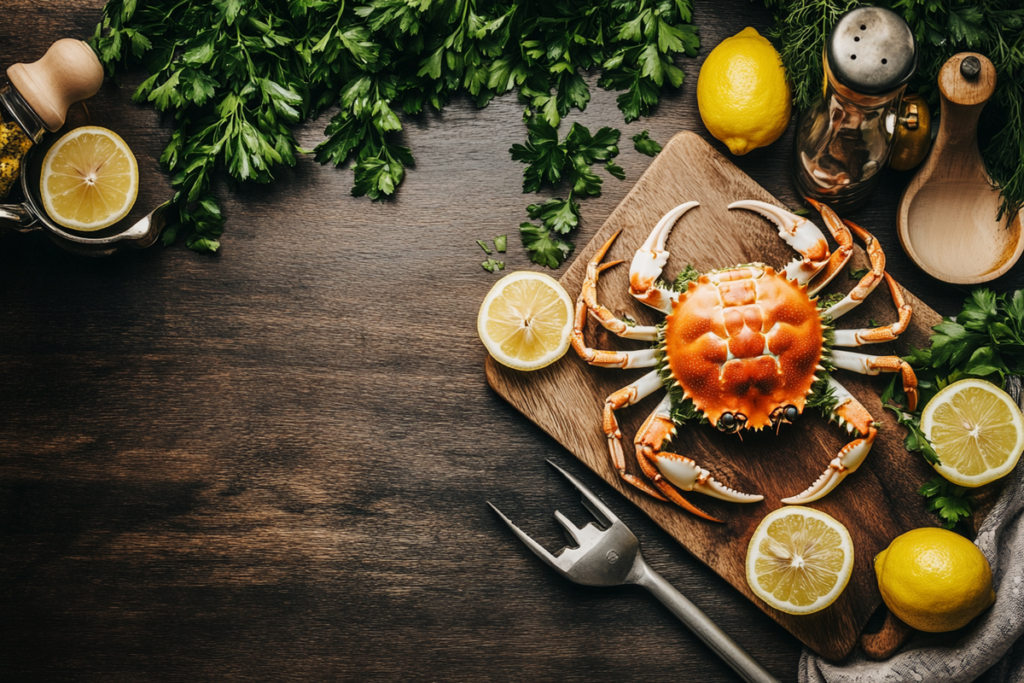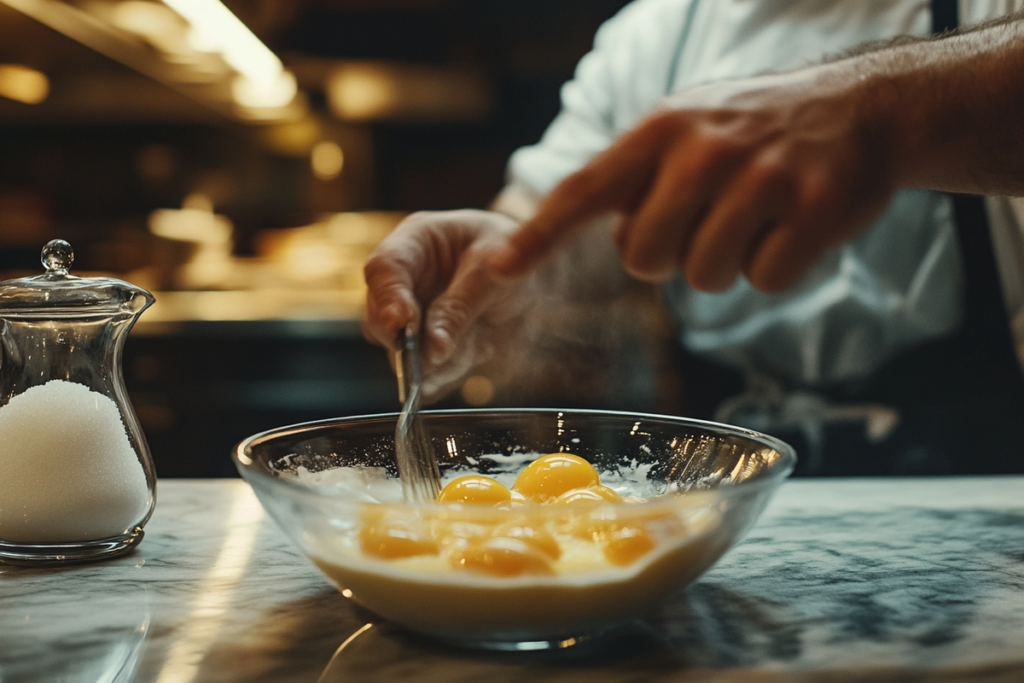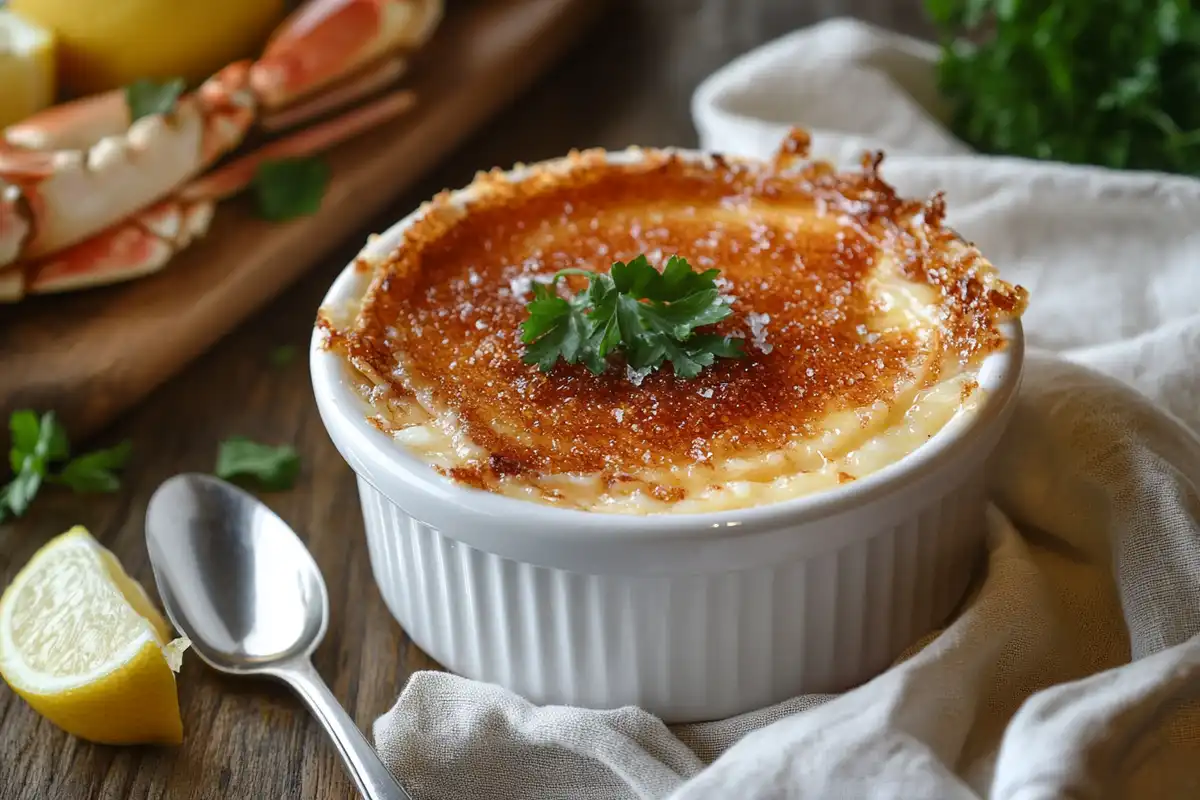Craving an appetizer that combines sophistication with an unexpected twist? This crab brûlée recipe transforms the familiar creamy delight of crème brûlée into a savory masterpiece. Packed with the sweetness of crab meat and the elegance of caramelized sugar, it’s the perfect blend of seafood and French culinary finesse. Whether you’re hosting a dinner party or looking to impress your family, this recipe delivers flavor and style in every spoonful. So, let’s dive into this step-by-step guide to crafting the ultimate crab brûlée.
Introduction to Crab Brûlée
What is Crab Brûlée?
Crab brûlée is a savory rendition of the classic crème brûlée. Instead of the sweet custard base, this dish marries the delicate sweetness of fresh crab meat with the silky smoothness of a seasoned custard. To top it off, a caramelized sugar crust provides the perfect contrast of texture. This dish is a favorite among food enthusiasts because of its unique flavor profile and eye-catching presentation.
The Origins of Crab Brûlée
While the traditional crème brûlée traces its origins to France, this savory twist was born out of culinary creativity. Chefs began experimenting with the idea of using seafood in unexpected ways, and voilà, crab brûlée emerged. It has since gained popularity for its ability to surprise and delight diners, especially when served as an appetizer or part of a gourmet spread.
Why Try This Recipe?
There are plenty of reasons to try a crab brûlée recipe! For one, it’s a versatile dish that can elevate any occasion, from holiday feasts to intimate dinners. The creamy custard complements the natural sweetness of crab, while the crispy top adds a delightful crunch. Besides, who wouldn’t want to serve something that feels as luxurious as it tastes?
Ingredients and Equipment
Essential Ingredients for Crab Brûlée
To create a truly memorable crab brûlée recipe, you need a combination of high-quality ingredients and just the right touch of seasoning. Here’s what you’ll need:
- Fresh Crab Meat: Use 1.5 cups of Dungeness crab or lump crab meat for its sweet, tender flavor. Canned crab can work in a pinch, but fresh is best!
- Heavy Cream: About 3 cups to form the luxurious base of the custard.
- Egg Yolks: You’ll need 6 large yolks to add richness and structure to the dish.
- Sugar: A tiny amount (1/2 teaspoon) for the custard, plus extra for caramelizing the top.
- Old Bay Seasoning: Just 1/2 teaspoon provides a warm and slightly spicy depth.
- White Pepper: Another 1/2 teaspoon for a subtle kick.
- Salt: A pinch to balance all the flavors.
Optional Ingredients for Enhanced Flavor
To elevate your crab brûlée further, you can experiment with optional ingredients:
- Grated Parmesan Cheese: For a nutty, savory topping instead of caramelized sugar.
- Cayenne Pepper: If you enjoy a spicy kick, add a tiny pinch.
- Fresh Herbs: A sprinkle of chopped parsley or dill for garnish will brighten up the presentation.
Necessary Kitchen Equipment
Having the right tools is crucial for executing this recipe with precision:
- Ramekins: Oven-safe dishes are essential for individual portions.
- Whisk: Ensures smooth blending of the custard ingredients.
- Baking Tray: To hold the ramekins securely while baking.
- Kitchen Torch: Creates that iconic caramelized crust effortlessly.
Preparing the Crab
Selecting the Best Crab Meat

The foundation of a great crab brûlée recipe lies in the quality of the crab meat. Dungeness crab is often the top choice for its delicate, sweet flavor and tender texture. If fresh crab isn’t available, high-quality lump crab meat—either frozen or canned—makes a suitable alternative. When using pre-packaged options, be sure to drain thoroughly and check for any remaining shell fragments.
Cooking and Cleaning Fresh Crab
If you’re working with fresh crab, the preparation process is simple but crucial:
- Boiling the Crab: Bring a large pot of salted water to a rolling boil. Add the whole crab and cook for approximately 15–20 minutes, depending on its size.
- Cooling: Remove the crab from the pot and let it cool slightly until it’s easy to handle.
- Extracting the Meat: Break off the claws and legs, then carefully crack open the shell. Gently extract the meat, ensuring no shell fragments remain.
Tips for Using Canned Crab Meat
If fresh crab isn’t an option, canned crab meat can still deliver excellent results:
- Drain and Pat Dry: Excess liquid can affect the custard’s texture, so make sure the crab meat is completely dry.
- Choose Premium Brands: Look for brands with minimal preservatives and no added flavors to ensure the pure taste of crab shines through.
- Enhance with Seasoning: Add a pinch of Old Bay or lemon zest to boost the flavor.
Crafting the Custard Base
Mixing the Custard Ingredients

The custard is the heart of your crab brûlée recipe. Achieving the perfect balance of creaminess and flavor is key:
- Heat the Cream: In a medium saucepan, combine 3 cups of heavy cream, 1/2 teaspoon of salt, 1/2 teaspoon of white pepper, and 1/2 teaspoon of Old Bay seasoning. Heat over medium-low until it begins to simmer, but don’t let it boil.
- Whisk Egg Yolks and Sugar: In a separate bowl, whisk 6 large egg yolks and 1/2 teaspoon of sugar until the mixture becomes pale and smooth.
- Temper the Eggs: Slowly pour a small amount of the warm cream into the egg mixture while whisking constantly. This prevents the eggs from scrambling. Gradually add the rest of the cream, continuing to whisk until fully combined.
Achieving the Perfect Custard Consistency
The consistency of your custard should be smooth and slightly thickened:
- Avoid Overheating: If the cream is too hot when added to the eggs, it can curdle. Keep the heat moderate and steady.
- Strain the Mixture: Pour the combined custard through a fine-mesh sieve to remove any lumps or air bubbles, ensuring a silky texture.
Seasoning Variations for Enhanced Flavor
While the classic combination of salt, pepper, and Old Bay seasoning works wonders, you can personalize your custard with additional flavor elements:
- Lemon Zest: Brightens up the dish with a hint of citrus.
- Herbs: Fresh thyme or dill can add an earthy undertone.
- Truffle Oil: A small drizzle offers a luxurious twist.
Assembling and Baking the Crab Brûlée
Layering the Ingredients
The secret to a perfect crab brûlée recipe is in the assembly. By layering the crab and custard thoughtfully, you ensure every bite is bursting with flavor:
- Prepare the Ramekins: Lightly grease the ramekins or oven-safe dishes to prevent sticking.
- Add the Crab Meat: Evenly divide the crab meat among the ramekins, ensuring a balanced layer at the bottom.
- Pour the Custard: Gently ladle the prepared custard over the crab meat, filling each ramekin about 3/4 full to leave space for the caramelized topping.
The Baking Process
Proper baking ensures the custard sets without becoming rubbery:
- Preheat the Oven: Set your oven to 325°F (160°C).
- Water Bath Method: Place the filled ramekins in a deep baking tray. Carefully pour hot water into the tray until it reaches halfway up the sides of the ramekins. This creates a gentle, even heat for cooking the custard.
- Bake: Transfer the tray to the oven and bake for 30–40 minutes, or until the custard is just set and jiggles slightly in the center when shaken.
Cooling and Preparing for Topping
Once baked, it’s important to let the crab brûlée cool properly:
- Remove from Water Bath: Carefully take the ramekins out of the tray using tongs or a thick towel.
- Cool at Room Temperature: Allow them to cool for about 15–20 minutes.
- Chill in the Refrigerator: Place the ramekins in the fridge for at least 2 hours (or overnight) to let the flavors meld and the custard firm up.
Tips for Avoiding Common Baking Mistakes
- Don’t Overbake: Overcooking can lead to a grainy texture. Remove the ramekins when the centers are slightly wobbly; they’ll continue to set as they cool.
- Watch the Water Level: Ensure the water doesn’t splash into the custard during baking, as it can ruin the consistency.
Creating the Caramelized Sugar Topping
Why the Topping Matters
The caramelized sugar crust is what transforms your crab brûlée recipe from delightful to extraordinary. It not only adds a sweet and crunchy contrast to the creamy, savory custard but also elevates the overall presentation of the dish.
How to Caramelize the Sugar
Follow these steps for the perfect golden crust:
- Sprinkle Sugar Evenly: After the ramekins have chilled, sprinkle a thin, even layer of sugar (about 1–2 teaspoons per ramekin) over the custard.
- Torch the Sugar: Use a kitchen torch to caramelize the sugar. Hold the flame about 2 inches away from the surface and move it in small, circular motions. The sugar will bubble, then harden into a crisp crust as it cools.
- Let Cool Slightly: Allow the ramekins to rest for 1–2 minutes so the caramelized sugar hardens fully before serving.
What if You Don’t Have a Kitchen Torch?
No torch? No problem! Here’s an alternative method:
- Oven Broiler: Preheat your oven’s broiler and place the ramekins on the top rack. Watch carefully as the sugar caramelizes, rotating the ramekins as needed to ensure even browning. This process takes just a few minutes, so don’t walk away!
Troubleshooting Caramelization Issues
- Uneven Browning: Make sure the sugar layer is uniform before caramelizing. Clumps of sugar can cause uneven melting.
- Burnt Sugar: If the flame or broiler is too close, the sugar can scorch. Keep a safe distance and move steadily for even caramelization.
Serving and Presentation Tips
Serving Your Crab Brûlée

Presentation is everything when it comes to a gourmet dish like crab brûlée. Follow these steps to make it truly stand out:
- Serve Immediately: Once the sugar crust has set, serve the brûlée while the top is still crisp for the best contrast of textures.
- Individual Portions: Present the brûlée in the ramekins it was baked in for a classic, elegant look.
- Temperature Matters: Serve slightly chilled custard with a warm, caramelized top for a delightful sensory experience.
Garnishing Ideas
Add visual appeal and subtle flavor enhancements with these garnish options:
- Herb Sprigs: A small sprig of parsley or dill adds a touch of color and freshness.
- Citrus Zest: A sprinkle of lemon or orange zest brightens up the dish.
- Edible Flowers: For a sophisticated touch, add a single edible flower like a pansy or nasturtium.
Pairing Suggestions
To make your crab brûlée recipe shine even more, consider pairing it with:
- Light Salads: A crisp arugula and fennel salad with a citrus vinaigrette complements the richness of the brûlée.
- Crusty Bread: Serve with slices of toasted baguette to balance the creamy texture.
- Sparkling Water or Tea: Refreshing drinks help cleanse the palate between bites.
When to Serve Crab Brûlée
This dish works beautifully as an appetizer for dinner parties, a standout course in a seafood-themed meal, or even a unique brunch option. Its luxurious flavor and creamy texture make it versatile enough for various occasions.
Storage and Reheating Tips
If you have leftovers (though it’s rare with this dish!), here’s how to store and enjoy them later:
- Refrigeration: Cover the ramekins with plastic wrap and store them in the fridge for up to 2 days.
- Re-Crisping the Top: Just before serving, add a fresh layer of sugar and re-caramelize with a torch to revive the crunchy crust.
FAQs About Crab Brûlée Recipe
What is crème brûlée mostly made of?
Crème brûlée is primarily made of a custard base composed of heavy cream, egg yolks, and sugar. In a crab brûlée recipe, these foundational ingredients are enhanced with fresh crab meat and savory seasonings, creating a unique twist on the classic dessert.
What is the secret to crème brûlée?
The secret to a perfect crème brûlée lies in achieving a silky smooth custard and a crackly caramelized sugar crust. For crab brûlée, using fresh crab meat and balancing the savory seasoning with just the right amount of sweetness ensures an irresistible dish. Tempering the eggs carefully and using a water bath during baking also prevent curdling.
What to use if you don’t have ramekins for crème brûlée?
If you don’t have ramekins, small mason jars, oven-safe bowls, or even espresso cups can be used as substitutes. Just ensure they are heatproof and shallow enough to allow the custard to bake evenly.
What’s the difference between crème brûlée and custard?
Custard is a broader term for any mixture of milk or cream and eggs thickened through cooking. Crème brûlée, and by extension crab brûlée, is a specific type of custard with a caramelized sugar topping. Crème brûlée is also typically richer and served as a standalone dish, whereas custard is often used as a filling or accompaniment.
Final Thoughts
This crab brûlée recipe combines elegance and creativity to deliver a dish that’s as visually stunning as it is delicious. Whether you’re serving it as an appetizer or experimenting with flavors in the kitchen, this dish is guaranteed to impress. Follow these detailed steps, let your creativity shine with garnishes, and enjoy the sweet-salty symphony of crab brûlée.

